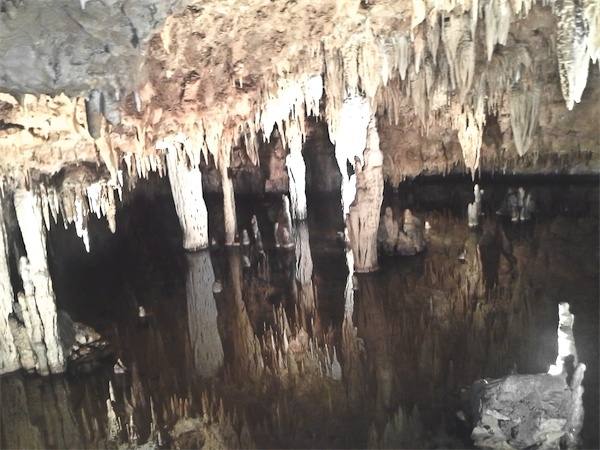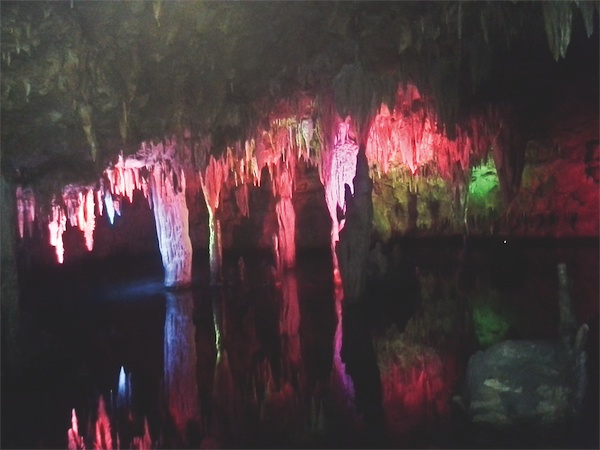When we think of caves, we tend to think dark, damp, cold, and full of bats – not a place that most people want to visit. But then there are caves without the bats, with lights, and with spectacular formations that garner “oohs and ahs” from all those that witness these creations of nature. Meramec Caverns, approximately 1 hour outside Saint Louis near Stanton, MO, get visitors from all over the world because of its “young and growing” cavern system. Nestled in the Meramec foothills, the natural cave system was carved from the limestone bedrock deposited by the inland sea approximately 100 million years ago. Rain water seeping through the limestone eventually created a subterranean stream, and it began the millennium-long task of carving a riverbed through the limestone. When there was enough room between the top of the cavern and the stream, the gradual dripping of calcium-laden rain water began to create the formations we see today, stalactites and stalagmites. Which go up and which go down? Think of the old adage: “The mites go up and the tights go down.”

Meramec Caverns, approximately 1 hour outside Saint Louis near Stanton, MO. (Photos provided)
As the centuries passes, flooding of the cavern and subsequent droughts help create one very rare formation, the wine table. Poised on three legs, the table is approximately six-feet tall in a corner of the cave system surrounded by “grape bunches,” formations that resemble grapes on a vine, thus the name. Only one other cave table is known to exist in the world and is located in France.
The cave has a long past, but also a modern history. Over the last few centuries Meramec Caverns has become known for its outlaws, its military significance, and its natural attraction as a dancehall.

The first commercial use of the cave was for mining. Potassium Nitrate (i.e. saltpeter from all those bats!) is used in the manufacturing of gunpowder and was mined from the cave system for over 100 years. This ended during the civil war when southern troops destroyed the operation. Later during the 1800s, the James gang used it as a hideout; robbing nearby banks and trains and then retreating to the cave for shelter and hiding. The Sheriff and his men eventually discovered the hideout, cornering the gang. Fortunately for the outlaws, they had explored the cave system sufficiently enough to find a “backdoor” and escaped the siege by the Sheriff. Artifacts from their occupation were found in the cave.
Years later, the large, main cavern was turned into a dance club. Transportation was provided, bringing revelers to the natural air conditioning provided by Meramec and escape from the heat and humidity of the St. Louis summers. A bandstand and disco ball remain as a symbol of that era in the cave’s life.
As Meramec became more of a commercial undertaking, the most outstanding section of the system was discovered. The “Stage Curtain” is a seemingly undulating wall of multiple stone formations extending over 70 feet tall, a towering rendition of curtains found in theaters at that time. Today there is a major light show and musical performance provided at the end of the tour all focused on the stone curtain formation.
While the cave system is the major attraction, there is also a “zip” line for the more adventurous, canoeing, and a boat ride that provides a scenic tour of the Meramec River itself. Easily accessible from the Interstate, Meramec Caverns can be enjoyed by all ages, but do bring a jacket – it’s a constant 58 degrees inside. Oh, and the bats are gone!




7 Comments
Well written and informative. Keep ’em coming
Dear mysundaynews.com owner, Keep the good content coming!
To the mysundaynews.com webmaster, You always provide practical solutions and recommendations.
Hi mysundaynews.com webmaster, Your posts are always a great source of information.
Hello mysundaynews.com webmaster, Your posts are always a great source of information.
Hello mysundaynews.com webmaster, Thanks for the comprehensive post!
Dear mysundaynews.com owner, Your posts are always well-delivered and engaging.